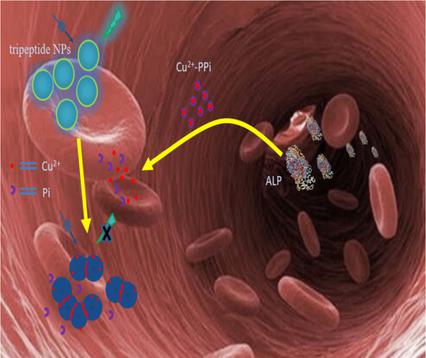当前位置:
X-MOL 学术
›
ChemNanoMat
›
论文详情
Our official English website, www.x-mol.net, welcomes your feedback! (Note: you will need to create a separate account there.)
A Self‐Assembling Tripeptide‐Based Fluorescence Bio‐Nanosensor
ChemNanoMat ( IF 3.8 ) Pub Date : 2020-08-16 , DOI: 10.1002/cnma.202000378 Pandeng Miao 1, 2 , Zhongdong Liu 2 , Man Liang 3 , Jun Guo 4, 5 , Tegexibaiyin Wang 1, 3 , Liping Wang 6 , Feng Zhang 1, 4, 5
ChemNanoMat ( IF 3.8 ) Pub Date : 2020-08-16 , DOI: 10.1002/cnma.202000378 Pandeng Miao 1, 2 , Zhongdong Liu 2 , Man Liang 3 , Jun Guo 4, 5 , Tegexibaiyin Wang 1, 3 , Liping Wang 6 , Feng Zhang 1, 4, 5
Affiliation

|
A de novo tripeptide, YFF, can self‐assemble into fluorescent nanostructures under ultraviolet irradiation, and their fluorescence can be selectively quenched by copper ions. Copper ions can co‐assemble with YFF NPs into hierarchical nanostructures, and the quenched fluorescence can recover again with the addition of pyrophosphate (diphosphate, PPi), which is due to the robust interaction between copper ions and PPi. Based on this principle, a simple and cost‐effective alkaline phosphatase (ALP) biosensor has been built up by making use of the specific dephosphorylation of ALP to PPi, in which the coordinated copper ions can reversibly bind to PPi, thus quench and recover the fluorescence of tripeptide nanostructures. The fluorescence intensity correlated well to the concentration of Cu2+ (2–100 μM), PPi (0–500 μM) and ALP (0–500 U/L) i, respectively, and the corresponding limits of detection (LOD) are 1.29 μM, 0.77 μM and 1.84 U/L, respectively. The designed tripeptide‐based nanosensor also exhibits biocompatible, robust sensing performance in serum, indicating its great potential application for clinical diagnosis.
中文翻译:

基于三肽的自组装荧光生物纳米传感器
从头三肽YFF可以在紫外线照射下自组装成荧光纳米结构,并且它们的荧光可以被铜离子选择性淬灭。铜离子可以与YFF NPs共组装成分层的纳米结构,淬火的荧光可以通过添加焦磷酸盐(二磷酸盐,PPi)再次恢复,这是由于铜离子和PPi之间的牢固相互作用。基于此原理,通过利用ALP对PPi的特定去磷酸化作用,构建了一种简单且经济高效的碱性磷酸酶(ALP)生物传感器,其中配位的铜离子可以可逆地与PPi结合,从而淬灭并回收三肽纳米结构的荧光。荧光强度与Cu 2+的浓度很好地相关(2–100μM),PPi(0–500μM)和ALP(0–500 U / L)i,相应的检测限(LOD)分别为1.29μM,0.77μM和1.84 U / L 。设计的基于三肽的纳米传感器在血清中还具有生物相容性,强大的传感性能,表明其在临床诊断中的巨大潜力。
更新日期:2020-08-16
中文翻译:

基于三肽的自组装荧光生物纳米传感器
从头三肽YFF可以在紫外线照射下自组装成荧光纳米结构,并且它们的荧光可以被铜离子选择性淬灭。铜离子可以与YFF NPs共组装成分层的纳米结构,淬火的荧光可以通过添加焦磷酸盐(二磷酸盐,PPi)再次恢复,这是由于铜离子和PPi之间的牢固相互作用。基于此原理,通过利用ALP对PPi的特定去磷酸化作用,构建了一种简单且经济高效的碱性磷酸酶(ALP)生物传感器,其中配位的铜离子可以可逆地与PPi结合,从而淬灭并回收三肽纳米结构的荧光。荧光强度与Cu 2+的浓度很好地相关(2–100μM),PPi(0–500μM)和ALP(0–500 U / L)i,相应的检测限(LOD)分别为1.29μM,0.77μM和1.84 U / L 。设计的基于三肽的纳米传感器在血清中还具有生物相容性,强大的传感性能,表明其在临床诊断中的巨大潜力。


























 京公网安备 11010802027423号
京公网安备 11010802027423号